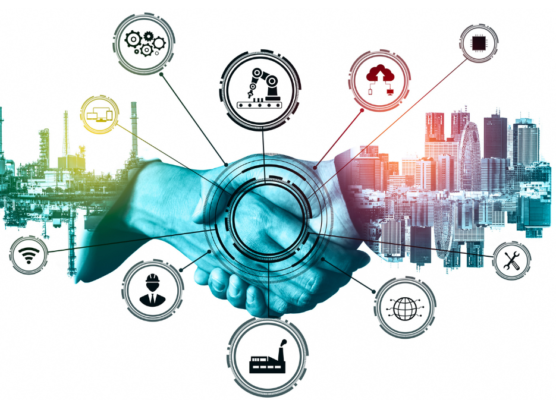Connected Shopfloor: Realising the Vision of Smart Manufacturing
- Prabal Laad

The industrial age has seen many changes and downturns over the past half-century, many of which have been impacted by uncertainties from war, pandemics, global recessions, and industrial hazards. As newer challenges continue to rise, modern day manufacturing needs to step up and challenge the status quo. Low throughput, lack of consistent product quality, patchy real-time data, and process visibility remain key factors that plague manufacturing.
In a 2023 report by the World Economic Forum and the University of Cambridge, the adoption of technology to realise the complete value of innovation is still in its nascent stages in traditional manufacturing. Besides, Deloitte’s 2023 Manufacturing Industry outlook report suggests demand for industrial, electrical, construction, defense and automotive products is still at a high globally, but skills gap and worker shortage has again made automation and digitisation imperative to manage current backlogs and improve efficiencies.
To summarise, the future of manufacturing will be a Connected Shopfloor – a method to bring about a step change in manufacturing in terms of its sophistication and to realise its full potential to address the challenges above. An important constituent is the ability to make it ‘smart’ using a confluence of people, process and technology. All 3 are important and this blog is more focused on the technology elements that should be considered such as:
which will bring a step change in manufacturing which binds humans and smart machines powered by AI, IoT and data analytics.
This blog will feature the below:
- What is a Connected Shopfloor?
- Building blocks of a Connected Shopfloor
- Transforming Manufacturing Processes
- Optimal Connected Shop Floor Architecture
- Benefits of a Connected Shopfloor
What is a Connected Shopfloor?
Connected Shopfloor is the way forward to enable the Smart factory of the future. This is largely driven by connecting machines using IoT and enabling AI to digitise industrial manufacturing processes. Connected Shopfloor makes machines smarter with IoT devices to capture production data in real time.
ERP platforms further connect the business users across an enterprise from various functions like finance, vendor management, leadership and so on and present them with a holistic view of the daily manufacturing processes for faster decision making.

A Connected Shopfloor also enhances the health and safety processes which can help eliminate hazards, breakdowns, and industrial accidents. Having quoted all these facts, the Connected Shopfloor will truly pave the way for Dynamic Manufacturing.
Building blocks of a Connected Shopfloor
Industrial engineering assessment helps to exactly pinpoint the areas of productivity loss. This assessment can be done by interviewing key workers from the shopfloor and supporting functions using a set of questionnaires. Study of historical patterns of production-related information, Time, and Motion Study on the shopfloor. Frequent breakdowns, recurrent rejections, patterns of low output. Analysis of such factors will draw up an exact roadmap of improvement initiatives by priority.
Integrating ERPs and Scheduling systems with Shop floor machines can help collect and report intermediate production data much faster. Machines can follow production schedules and actual production data can be passed back from machines to planning & scheduling systems so that future schedules can be adjusted faster. ERP systems like SAP ME/MII and Oracle MOC/MES automatically integrate, control, store, and report data.
Most modern machines today come with integration standards so that they can be brought under an integration framework. Using IoT sensors such machines can be connected under an integration framework. The outcome is a Connected shopfloor where critical machines, ERP platforms, Scheduling systems, and Reporting Systems talk to each other and help users make critical timely decisions.
In case if the machines are unable to integrate for any reason, digital touch screen kiosks can be used to move away from the paper centric operator workstations.
For users like supervisors and management who are often working remotely or away from the manufacturing setup, the use of mobile communication devices can help with immediate reporting and faster decision-making.
Certain manufacturing processes rely on data that is based on comparison and deviation analysis to help to understand current production batch parameters with past historical batch data. Traditionally this is achieved while a batch is in process. However, using the power of SAP HANA, the same deviation analysis can be computed, including drawing inferences from historical batch data to help corrective decision making.
Building blocks of a Connected Shopfloor
Manufacturing continues to face a huge window between machinery breakdown and the resumption of operations which causes poor output and delays. As per Lean Manufacture, there could be possibilities that a plant may not be operating within its design capacity and load. They also emphasize the importance of readily available information about the plant and spare parts. Also, Lean Manufacturing suggests historical data like the last preventive plant or machine maintenance is key.
Let’s see how the traditional manufacturing processes will change based on the Connected Shopfloor approach below:

Optimal Connected Shopfloor Architecture

Optimal Connected Shopfloor Architecture
With its commitment to Smart Manufacturing, a Connected Shopfloor can bring on the below benefits:

Connectivity of the manufacturing setup:
Once the machines are bound by digital kiosks and enterprise software platforms, the manufacturing setup is no more an isolated working entity. It has truly become an integral part of the corporate boardroom and even connecting with the entire organization and working to achieve the business goals. Various teams whether from operations, maintenance, company management, or even regulators are now connected with this shopfloor. For example, using IoT, Energy consumption patterns can be tracked and used for predicting failures, lowering energy and compliance costs, and less unplanned downtime.
Real-time data and analytics:
The age-old concept of accessing manufacturing data postproduction can be eliminated. An example is InspireXT’s PlantConnect Digital Asset Management (DAM) which acquires manufacturing data from machines, energy meters, utilities, etc. in real time and then processes this data in a cloud environment and further tops it up with intelligence to be presented to different users like Supervisors, Engineers, Managers, and Top Management. Each user can view what is relevant to them at real-time and even from a different location.
Faster data-driven decision making:
Cloud-enabled data processing and reporting is a huge leap for end users as compared to reporting which is accompanied by a massive breakdown or even worst an industrial accident. Even a few hours of early reporting can help management to take enhanced decisions and save lives and avoid environmental disasters which have been very common in the industrial age.
Operational Intelligence:
Using IoT, data can be blended and analysed in real-time, enabling managers to improve operational efficiency and utilisation.
Enhanced shopfloor processes:
This digitised shopfloor will reimagine the processes and make the worker’s life much easier. Integrated workflows from production scheduling to inspection now mean a more standardised and faster product lifecycle. Besides, adding intuitive human and machine interfaces (HMI) like kiosks and ERP platforms can help workers interact with machines much better. Another additional benefit of the HMI layers is immediate and real-time reporting of any downtime or disruptions by workers at their fingertips. Critical areas like handling hazardous materials with IoT-enabled monitoring and detection can enable users to remotely maintain safety and adhere to storage and handling standards.
An integrated Smart Manufacturing ecosystem:
Finally, the connected shopfloor is now a well-connected and controllable manufacturing site with real-time data access and end-to-end environment visibility. The machines are now smarter as the real-time data amplifies challenges, hazards, and opportunities much faster and with more accuracy. Besides, the holistic visibility within every process will make sure the production line is always connected with 360⁰ visibility.
How InspireXT is enabling Smarter Manufacturing?
InspireXT’s IoT Platform is a single unified system for all connected assets and operations. Our Connected Shopfloor platform leverages AI and IoT to eliminate siloed systems in favor of optimal streamlined processes to allow greater agility and stronger collaboration. This approach enables manufacturing companies to innovate and produce high quality products and meet customer demands in a cost efficient and safe way.
Request for services
Find out more about how we can help your organisation navigate its next. Let us know your areas of interest so that we can serve you better.




